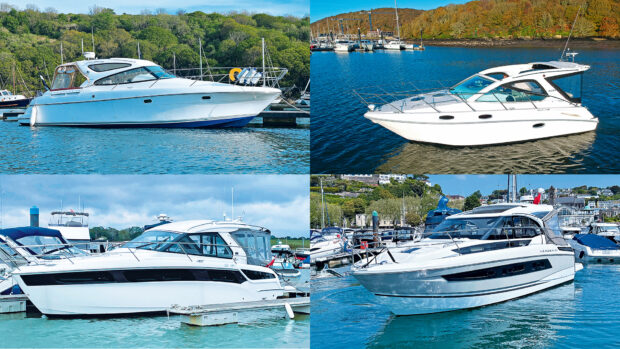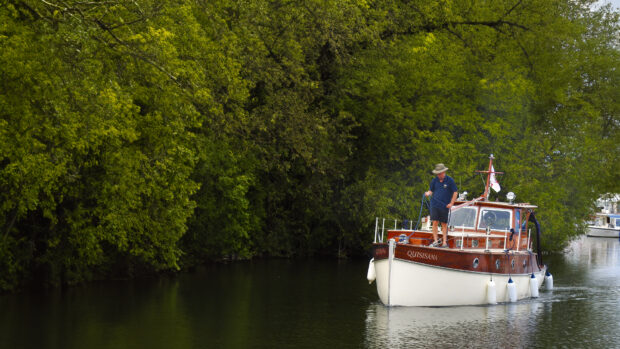A 40ft flybridge is a great cruiser with enough space and clever layout. We review four secondhand boats on the market now: Jeanneau Velasco 43, Oyster Powerline 390, Princess 414 and Fairline Phantom 40
If you had to come up with the perfect type and size of family boat for UK waters, the 40ft flybridge cruiser would be right up there, a theory backed up by the sheer number in south coast marinas from Brighton to Falmouth. Big enough to go properly offshore, twin engines will give Channel-crossing confidence as well as manoeuvrability in harbours, where their relatively compact size makes handling manageable for two people.
The layout works well too, with an open-air helm for good weather and an indoor driving position for days full of liquid sunshine.
The ‘patio’ doors and a large windowed saloon make them perfect floating apartments while most have a family-friendly two cabin layout. Add in relative affordability and it’s easy to see the appeal. So this week we bring you four prime examples, from a well loved old Princess via a quirky Oyster Powerline through to an alternative Jeanneau hybrid design to a ‘staple diet’ Fairline.
Jeanneau Velasco 43

Jeanneau seems to have a model range for every niche but it hasn’t stopped them inventing a new one to fill. Launched in 2013 initially as the 43 Voyager before a sudden name change to Velasco, this concept is a cross between a long distance trawler and a fast port-hopping flybridge cruiser.
Interior

There is plenty of trawler thinking on the inside. From fundamental things like the trawler-style galley forward on the main deck and the sliding door next to the helm through to more subtle hints at long distance cruising such as the massive storage voids beneath the main deck floor, one big enough to house a washing machine. On the lower deck it’s a two-cabin, two- heads layout. The guest cabin, with its two single berths infilling to create a double, is pushed back, which leaves space for a large ensuite master cabin forward.

Exterior
The most obvious nod to the trawler-esque thinking is the forward sloping windscreen rather than the usual sleeker raked back look. With thin mullions it offers terrific visibility and it gives the boat a distinctive, purposeful look. Interestingly, Jeanneau has reverted to a swept back screen for its latest version, now called the Velasco 43F. Likewise, the mast-like radar support on the flybridge has been ditched in favour of a conventional arch.
Performance
Bucking the trend again, there are no Volvo motors on the options list, just a default choice of twin Cummins QSB6.7L producing 380hp and running through vee drives for a top speed of 27 knots.
Seakeeping
That cruiser/trawler hybrid concept is more than just styling and marketing puff. The hull of the Velasco is also modified with fuller forward sections, a shallow keel and a small bow bulb to allow efficient comfortable long distance cruising as well as running well at planing speeds. It’s largely successful at doing so too, although it can ship a fair bit of water at planing speeds in choppy seas.
At a glance…
Built: 2013
Price: £279,950
LOA: 44f t11in (13.7m)
Beam: 13ft 6in (4.1m)
Draught: 3ft 7in (1.1m)
Displacement: 10.1 tonnes
Fuel Capacity: 1,200 litres
Engines: Twin Cummins QSB 6.7 380hp diesels
For Sale: Burton Waters Sales
Oyster Powerline 390

Famous for its high end sailing yachts, Oyster dabbled with the motor boat market in 2005, building the elegant ‘gentleman’s motor yacht’ LD43 until 2011. What’s less well known is that this wasn’t Oyster’s first foray into motor boats. In 1989 the company brought out a very conventional looking 40ft flybridge cruiser called the Powerline 390. It was intended to be the first of a range of flybridge cruisers, but was the only Powerline model, due partly to the 1990s recession.
Interior

Oyster didn’t attempt to reinvent the wheel with this boat so the layout is entirely conventional. There’s a master cabin in the bow, a guest cabin with twin bunks to starboard and the galley opposite on the lower deck with the lower helm and saloon up on the main deck. Finish is good, as you’d hope from Oyster, with a light ash veneer, and the company’s yacht builder roots show through in things like the fiddled horizontal surfaces and large chart table at the helm.

Exterior
Maximum geek points if you spotted Humber 38 underpinnings. In fact Oyster adopted that boat’s John Bennett-designed hull when Humber moved on to launch its aft cabin Humber 40, but fitted its own deck and superstructure. And it’s undeniably a handsome-looking boat for its era, with more curves than were typically the norm back in the 1980s. The flybridge is accessed by a ladder and the transom has a semi transom door formed by a cutaway.
Performance
Twin Cummins 6BTAs were the engines of choice for the Powerline 390, in either 250hp or 300hp guise. This boat has the latter, which should push the top speed to 30 knots.
Seakeeping
Unusually for a full planing boat, the hull has a keel that extends to nine inches at its maximum, offering some protection to the sterngear and helps it track straight at low speed in strong beam winds. It’s a solid feeling boat and a relatively quiet one too.
At a glance…
Built: 1991
Price: £85,000
LOA: 39ft 7in (12.1m)
Beam: 13ft 8in (4.2m)
Draught: 3ft 0in (0.9m)
Displacement: 10 tonnes
Fuel Capacity: 1,090 litres
Engines: Twin Cummins 6BTA 300hp diesels
For Sale: TBS Boats
Princess 414

Old boats generally offer a huge amount of bang for buck, but that’s because they’re, well, old. Old electrics, old upholstery, old carpet, old navigation equipment. Not this one though, because all
of that was replaced during a 2016 refit that even saw new tanks installed and the engines removed and overhauled by a Volvo Penta main dealer. Total cost? More than the current asking price…
Interior

The only aft cabin boat of our quartet this month, the interior stretches from end to end. And bear in mind that this was a 41ft boat when they were measured to the transom, not to the end of an extended bathing platform! As a result, the accommodation is palatial. A huge ensuite master cabin dominates the rear section beneath the aft deck, a large saloon sits amidships and further forward there’s a big dinette opposite the galley plus a guest cabin with centreline double berth in the bow.

Exterior
The payoff for that aft cabin layout is a raised aft deck. More exposed than an aft cockpit and lacking the shelter of a flybridge overhang, it’s still big and does have one particularly useful feature. Where virtually all flybridge boats of this era had ladders to scale in order to reach the flybridge, on this boat it’s a couple of steps — easy to negotiate and it connects these two areas well.
Performance
The other trade-off with older boats is less powerful engines than we’re used to these days. But in this case the boat has a pair of entirely reasonable Volvo Penta TAMD 60C 255hp motors. No, you won’t be hitting the magic 30 knots, but it should top-out toward the mid twenties and cruise in the high ‘teens, perfect for a classy old lady.
Seakeeping
One of the last of the John Bennett hulls before Princess switched to Bernard Olesinski, it’s a conventional planing hull with
a modified deep-vee hull that combines deep forward sections with a flatter aft profile for seakeeping and speed.
At a glance…
Built: 1989
Price: £99,500
LOA: 41ft 2in (14.7m)
Beam: 13ft 0in (4.0m)
Draught: 3ft 0in (0.9m)
Displacement: 9 tonnes
Fuel Capacity: 1,182 litres
Engines: Twin Volvo Penta TAMD 60C 255hp diesels
For Sale: Global Yacht Brokers
Fairline Phantom 40

The early noughties was considered by many to be a golden era for Fairline boats, and the really good news is that the exemplary build quality echoed through the range from the flagship Squadron 78 downwards. So even buyers of 40-foot flybridge boats like this one benefit from fantastic attention to detail.
Interior

Nowhere is that more obvious than inside, where the high quality wood has a superyacht level of finish to it and that attention to detail includes a sturdy handrail recessed into the saloon headlining. The layout is the usual master forward, twin cabin to starboard with both having decent sized ensuites (the guest cabin accessing the day heads). There’s also a folding sofa bed cunningly hidden beneath the saloon settee taking sleeping capacity to an occasional six.

Exterior
Again, pretty unadventurous but even so, beautifully appointed, the deck area of the Phantom 40 simply works well. Bathing platform and cockpit are teak laid as standard, side decks are 10 inches wide and protected by strong, high rails and the flybridge offers triple seats at the helm and a huge dinette aft.
Performance
When it was launched in 2003, Fairline fitted a pair of Volvo Penta TAMD 63 engines in either L (316hp) or P (370hp) specification, with twin Caterpillar 3126 units of 355hp or 385hp as an option, which offered top speeds in the high 20 knots. Later boats (like this one) moved on to the D series that Volvo Penta brought out in 2005, which in the case of the 435hp versions fitted to this boat, lift the top end beyond 30 knots.
Seakeeping
Like everything else on this boat, the hull design is entirely predictable, being a Bernard Olesinski design, but like everything else, all the better for it. It extends beneath the bathing platform for maximum planing surface area aft and features semi-tunnelled propellers for a straighter, more efficient shaft angle and lower engines.
At a glance…
Built: 2009
Price: £229,000
LOA: 41ft 2in (12.53m)
Beam: 13ft 0in (4.0m)
Draught: 3ft 3in (1.0m)
Displacement: 11.6tonnes
Fuel Capacity: 990 litres
Engines: Twin Volvo Penta D6-435 435hp diesels
For Sale: Global Yacht Brokers

VIDEO: Princess F45 first look
We get on board the Princess F45 after its global debut at the 2019 Düsseldorf Boat Show

10 Most iconic Fairline motor yachts of all time
Oundle-based Fairline Yachts started building boats in 1967 and in the last 51 years they have created a stunning range











